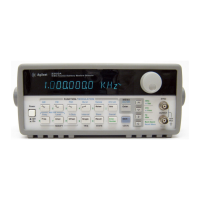In amplitude modulation, the amplitude of the carrier varies between
zero and twice its normal value for 100% modulation. The percent
modulation depth is the ratio of the peak information signal amplitude
to the constant.
When amplitude modulation is selected, the 33120A
automatically reduces its peak-to-peak amplitude by one-half so that
a 100% modulation depth signal can be output
. Amplitude settings
are defined to set the 100% peak-to-peak amplitude independent of the
modulation depth setting. Vrms and dBm amplitude settings are not
accurate in AM since signals are very complex.
Frequency Modulation (FM) Frequency Modulation is a process of
producing a wave whose frequency varies as a function of the
instantaneous amplitude of the modulating information signal.
The extent of carrier frequency change is called deviation. The
frequency deviations are caused by the amplitude changes of the
modulating information signal. You can set the amount of the peak
frequency in
FM with the deviation parameter.
In frequency modulation, “100% modulation” has a different meaning
than in
AM. Modulation of 100% in FM indicates a variation of the
carrier by the amount of the full permissible deviation. Since the
modulating signal only varies frequency, the amplitude of the signal
remains constant regardless of the modulation. The function generator
uses the deviation parameter to describe the peak frequency change
above or below the carrier in response to a corresponding amplitude
peak of the modulating signal. For
FM signals, the bandwidth of the
modulated signal can be approximated by:
BW 2 x (Deviation + Information Signal Bandwidth) For wideband FM
BW 2 x (Information Signal Bandwidth)
For narrowband FM
Narrowband FM occurs when the ratio of the deviation frequency to the
information signal bandwidth is approximately 0.01 or less. Wideband
commercial
FM radio stations in the United States use a 75 kHz peak
deviation (150 kHz peak-to-peak) and audio signals band-limited to
15 kHz to achieve 200 kHz channel-to-channel spacing from the
180 kHz bandwidth.
Chapter 7 Tutorial
Modulation
288

